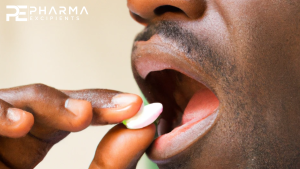Inulin-Lipid Core–Shell Microcapsules Target the Gut Microbiota and Mimic the Pharmaceutical Food Effect for Improved Oral Antipsychotic Delivery

Abstract
The oral delivery of most atypical antipsychotics is severely challenged by their low oral bioavailability and significant food effects that necessitate patient compliance. Lipid formulations are an attractive delivery system for overcoming the dosing challenges of antipsychotics, but their negative impact on the gut microbiota can interfere with the pharmacodynamic response through disruption of the gut-brain axis. Here, novel gut microbiota-targeting microcapsules are engineered to provide a multifunctional approach for improving both the pharmacokinetic and pharmacodynamic properties of the antipsychotic, lurasidone. The microcapsules are comprised of a lipid core that facilitates the solubilization and oral absorption of the lipophilic drug and an outer carbohydrate polymer (inulin) shell that positively modulates the gut microbiota by facilitating microbial fermentation. Fed-fasted variability in lurasidone solubilization is mitigated through microencapsulation with inulin-lipid microcapsules (ILM), while microbiota enrichment is coupled with enhanced serotonin levels in the small intestine, faeces, and plasma. The realization of multifunctional ILM confirms the pharmacokinetics and efficacy of mental health therapies, such as antipsychotics, can be optimized through strategic encapsulation within functional formulations that target the gut microbiota for effective modulation of the gut-brain axis.
Introduction
New knowledge surrounding the gut-brain axis has highlighted the importance of the gut microbiota in treating mental health conditions.[1] The microbial communities that colonise the gut regulate mood and cognition through the production of neurotransmitters and mood stabilisers (e.g., serotonin and dopamine).[2, 3] Despite this, many psychotropics used for the treatment of mental health conditions negatively disrupt the gut microenvironment through antibiotic-like mechanisms and trigger a cascade of metabolic side effects, most notably, weight gain.[4, 5] This is especially the case for antipsychotics used in the treatment of schizophrenia, including olanzapine, clozapine and risperidone, which induce microbiota imbalances that ultimately limit their therapeutic efficacy.[6-9]
Lurasidone, however, is an atypical antipsychotic that has been recently shown to positively modulate the gut microbiota in rats, without the commonly observed adverse effects of other atypical antipsychotics.[10] Longitudinal analyses revealed that daily lurasidone administration increased the relative abundance and diversity of the gut microbiota after just 7 days. Despite its advantageous properties toward the gut microbiota, lurasidone suffers from low aqueous solubility leading to poor oral bioavailability (in the reported range of 9–19%) and a significant pharmaceutical food effect where bioavailability varies up to 3.5-fold depending on patient food intake (or lack thereof).[11] These oral dosing challenges limit the clinical adoption of lurasidone since dosing relies on patient compliance with patients being recommended to take their medication with a meal (at least 350 kcal).[12, 13] This represents a clear clinical challenge given schizophrenia and bipolar patients represent a noncompliant cohort.[14]
To overcome bioavailability challenges, lurasidone has been previously formulated with lipid-based carriers that enhance intestinal solubilization and absorption.[15-18] However, recent studies have shown that common excipients used in lipid-based formulations disrupt the gut microbiota and induce intestinal inflammation.[19-21] Given the role of the gut-brain axis in mental health, such lipid-based carriers are not feasible formulation strategies for antipsychotics. Thus, novel advanced material-based formulation strategies are urgently required for mitigating the food effect and enhancing the oral absorption of lurasidone, in combination with exerting positive or neutral effects on the gut microbiota.[22]
In this study, inulin-lipid core–shell microcapsules were strategically engineered to overcome antipsychotic dosing challenges by simultaneously targeting the gut microbiota and mimicking the food effect of lurasidone. Recent clinical investigations have shown that the pharmacodynamic response of antipsychotics can be enhanced by co-dosing with microbiota-active materials that positively regulate the gut-brain axis.[23-25] Therefore, inulin was selected as a microbiota-active coating for the core–shell microcapsules, given its capacity to be readily fermented by intestinal microbes, enabling widespread metabolic and mental health benefits.[26-29] It was hypothesised that the presence of inulin, a microbially accessible carbohydrate, within the formulation would mitigate dysbiosis caused by the lipid carriers, while the medium-chain triglyceride core would enable solubilization and bioavailability enhancement of the encapsulated lurasidone. Spray drying was selected as the fabrication technique due to its capacity to induce the formation of core–shell microcapsules and its common application within the pharmaceutical industry. The findings derived from this study are expected to drive the future development of microbiota-active drug delivery technologies across an array of indications, enabling these advanced materials to serve as bioactive formulations that extend the pharmacological activities of drugs, while mitigating metabolic adverse effects.
Download the full article as PDF here Inulin-Lipid Core–Shell Microcapsules Target the Gut Microbiota and Mimic the Pharmaceutical Food Effect for Improved Oral Antipsychotic Delivery
or read it here
Materials
Lurasidone and ziprasidone powders with purity >99.0% were purchased from Hangzhou Dayangchem Co. Ltd. (Hangzhou City, China). Inulin from dahlia tubers (with a degree of polymerization of 35), soybean lecithin, phosphate-buffered saline (PBS), 4-bromophenylboronic acid (4-BBA), 1,2- dioleoyl-3-[16-N-(lissamine rhodamine B sulfonyl) amino]palmitoyl-sn-glycerol, FITC-inulin, and deuterium oxide (D2O) were purchased from Merck (Bayswater, Australia). Capmul MCM, a mix of medium-chain glycerides, was kindly supplied by Abitec Pty Ltd (NSW, Australia). 3F (FaSSIF/FeSSIF/FaSSGF) powder was purchased from Biorelevant.com Ltd (London, United Kingdom). Porcine pancreatin extract (activity equivalent to 8 × USP specification) was supplied by MP Biomedicals (Seven Hills, Australia). Heparin sodium and saline 0.9% were purchased from Lyppard Australia (Beverley, Australia). All chemicals and solvents were of analytical grade and used as received. High-purity Milli-Q water was used throughout the study.
Tahlia R. Meola, Aurelia Elz, Anthony Wignall, Kara Paxton, Alexander Hunter, Amin Ariaee, Srinivas Kamath, Stephanie E. Reuter, Clive A. Prestidge, Paul Joyce, Inulin-Lipid Core–Shell Microcapsules Target the Gut Microbiota and Mimic the Pharmaceutical Food Effect for Improved Oral Antipsychotic Delivery, First published: 25 April 2024 https://doi.org/10.1002/adfm.202403914
Read also our introduction article on Orally Disintegrating Tablets (ODTs) here:


